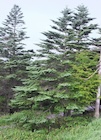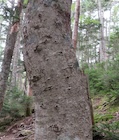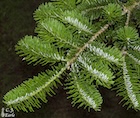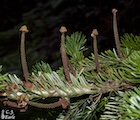Conservation Status

Abies veitchii
Lindley 1861
Common names
シラビソ 白檜曽 shirabiso [Japanese], Veitch's silver fir, Shikoku fir.
Taxonomic notes
A generally-accepted species, endemic to Japan, in Abies section Balsamea. There are two varieties, the type and Abies veitchii var. sikokiana (Nakai) Kusaka 1954. Type: "Mt. Fusi-Yama". Natural hybrids with A. homolepis as the pollen parent have been recorded from Mt. Fujiyama, where the two species co-occur near the lower elevation limits of A. veitchii (Isoda et al. 2000). Such hybrids are rare, representing two different sections of Abies.
Synonymy (POWO, accessed 2023.11.26):
- Picea veitchii (Lindley) Gordon 1862;
- Pinus selenolepis Parl. 1868;
- Pinus veitchii (Lindley) McNab 1876 nom. illeg.;
- Pinus nephrolepis (Trautv. ex Maxim) Voss var. veitchii (Lindley) Voss 1907;
The type variety has several heterotypic synonyms:
- Abies eichleri Lauche 1882;
- Abies veitchii Lindley var. nikkoensis Mayr 1890;
- Abies nordmanniana (Steven) Spach var. eichleri (Lauche) Beissn. 1891;
- Abies veitchii Lindley var. olivacea Shiras. 1913;
- Abies veitchii Lindley var. reflexa Koidz. 1916;
- Abies veitchii Lindley var. komagatakensis Hayashi 1952;
- Abies veitchii Lindley f. olivacea (Shiras.) Cinovskis 1974.
Var. sikokiana has two homotypic synonyms:
- Abies sikokiana Nakai 1928;
- Abies veitchii Lindley subsp. sikokiana (Nakai) Silba 2008.
Description
Trees to 30 m tall and 100 cm dbh, typically with a single straight trunk and a narrowly pyramidal crown of short, straight primary branches. Bark first smooth, greenish-gray with prominent resin blisters, later becoming dark gray and scaly. Twigs in first year slender, green or light brown, smooth, with dense yellow pubescence; in later years turning gray, shallowly grooved, glabrous; leaf scars circular. Buds small, ovate-globose, very resinous. Leaves spirally arranged, directed forwards, pectinate on shade foliage, radially spreading on sun foliage, (5-)15-30(-38) × 1.5-2.2 mm, widest near the truncate or emarginate apex, linear to falcate, flattened, upper surface dark green with a medial groove, lower surface lighter with two whitish stomatal bands flanking a midrib, resin ducts medial or occasionally sub-marginal. Pollen cones lateral, axial, pendant, 10-15 mm long, yellowish with red microsporophylls when fertile (in May). Seed cones lateral, erect, often crowded on the shoot, almost sessile, cylindrical to ellipsoid, often irregular, 4.5-7.5 × 2-2.5 cm, bluish violet ripening dark brown; rachides persistent, narrowly conical, purplish-brown; ripening in September-October. Seed scales narrowly reniform or crescentic, 8-10 × 14-16 mm at mid-cone, smooth, upper margin entire and incurved; bracts obcordate, 10-12 mm long, very slightly exserted. Seeds cuneate, dark gray, 5-6 mm long with a dark broad-cuneate wing 5 mm long. Cotyledons 3-5 (Vidakovic 1991, Farjon 2010). See García Esteban et al. (2004) for a detailed characterization of the wood anatomy.
According to Farjon (2010), var. sikokiana is distinguished by its short leaves (8-20 mm, vs. 15-30 mm in the type variety) and small seed cones (3-4 × 1.5-2 cm, vs. 4.5-7.5 × 2-2.5 cm in the type variety). A. veitchii is distinguished from the other subalpine fir of Honshu, Abies mariesii, by its longer and more slender needles.
Distribution and Ecology
Japan: Honshu and Shikoku, at elevations of (1050-)1200-2800 m, typically on volcanic, podzolic soils. Var. sikokiana is restricted to Shikoku. Climate is cool moist maritime, with 1000-2500 mm annual precipitation, including heavy winter snows. Commonly occurs in mixed stands with, e.g., Abies mariesii, Picea jezoensis ssp. hondoensis, Larix kaempferi, Pinus parviflora, Thuja standishii, Tsuga diversifolia, and at the highest elevations Pinus pumila (Farjon 2010).
Franklin et al. (1979) found that these forests "have luxuriant understories in which herbs and ferns are conspicuous" (also, sometimes, the shrub bamboo Sasa paniculata) and that Abies (A. mariesii and A. veitchii) are the most shade-tolerant conifers present, allowing them to achieve dominance in old forests. They also found that typhoons are the major disturbance: "they are the major agent of forest destruction and bring heavy summer rains. Wildfires are negligible influences in these forests, but typhoons sweep the mountains every year. Essentially every location can expect a highly destructive typhoon (i.e., one that blows down essentially all of the overstory) during a period of one or two centuries. The oldest forests are no more than 250-300 yr old, and most are younger." The changes that an Abies forest experience in the aftermath of a major typhoon were explored by Suzuki (2016) in a study that followed an old A. mariesii/A. veitchii dominated forest from 1947, through a 1959 typhoon, and on to 2012.
The coexistence of A. veitchii and A. mariesii, two highly shade-tolerant species that seemingly occupy the same niche, was explored by Kohyama (1984). He found that in pure Abies stands, A. veitchii quickly achieves dominance due to rapid early height growth. In mixed conifer-hardwood stands, though, both Abies species begin life in the understory, and A. mariesii shows superior performance in such densely shaded stands; eventually the short-lived hardwoods die out, leaving A. mariesii as the canopy dominant species (Kohyama 1984). These two species also compete in the rather exotic environment of a fir wave forest. Fir waves are a cyclic disturbance-regeneration cycle in which the death of overstory trees produces sunlight and warmth on the forest floor, allowing seedling regeneration. Once the seedlings become canopy dominant trees (about 60 years later), darkness, cold, and poor nutrient availability cause the death of the overstory trees. This cycle produces waves of growing, dying and dead trees that sweep across the landscape (Sprugel and Bormann 1981, Kohyama 1988, Suzuki 2016). Such forests are particularly found on Mt. Shimagare, called the "mountain with dead tree strips". The roles of A. mariesii and A. veitchii in fir wave forests on Honshu were studied by Ugawa et al. (2007), who found that persistence of A. veitchii was due to abundant seed production, while persistence of A. mariesii was due to high shade tolerance; essentially, a K vs. r strategy game. Suzuki (2016), studying similar forests but over a much longer timeframe, largely confirmed the findings of Kohyama (1984) and Ugawa et al. (2007), but also perceived that the competition between these two species probably favors one or the other in response to a variety of factors, such as initial site conditions, type of disturbance, time since disturbance, and transient effects such as climate episodes or lower-severity disturbance.
Abies veitchii is rated "least concern" for conservation, due primarily to its abundance. It is protected in some mountainous areas, but population decline and fragmentation are a concern at lower elevations (Katsuki et al. 2011, accessed 2023.11.26).
This species is hardy to Zone 3 (cold hardiness limit between -39.9°C and -34.4°C) (Bannister and Neuner 2001).
Remarkable Specimens
No data as of 2022.12.31.
Ethnobotany
The species has seen limited exploitation for its timber, which is used primarily for pulp. It is a fairly popular ornamental in areas with suitable climate (Farjon 2010).
Observations
No data as of 2022.12.31.
Remarks
"I have named it after Mr. J. G. Veitch, whose great merit as a very energetic explorer of the vegetation of Japan it gracefully records" (Lindley 1861).
Citations
Franklin, Jerry F., T. Maeda, Y. Ohsumi, M. Matsui, H. Yagi, and Glenn M. Hawk. 1979. Subalpine coniferous forests of central Honshu, Japan. Ecological Monographs 49(3):311–34. https://doi.org/10.2307/1942487.
Isoda, K., S. Shiraishi, S. Watanabe, and K. Kitamura. 2000. Molecular evidence of natural hybridization between Abies veitchii and A. homolepis (Pinaceae) revealed by chloroplast, mitochondrial and nuclear DNA markers. Molecular Ecology 9(12):1965-1974.
Iwata, J. and M. Kusaka. 1954. Conif. Jap. Ill. Aject. Emend.:212.
Kohyama, Takashi. 1984. Regeneration and coexistence of two Abies species dominating subalpine forests in central Japan. Oecologia 62:156-161.
Kohyama, Takashi. 1988. Etiology of ‘Shimagare’ dieback and regeneration in subalpine ‘Abies’ forests of Japan. GeoJournal 17(2):201–8. http://www.jstor.org/stable/41144287.
Lindley. 1861. Gardeners' Chronicle 23. Available: Biodiversity Heritage Library, accessed 2023.11.26.
Sprugel, D. G., and F. Bormann. 1981. Natural disturbance and the steady state in high-altitude balsam fir forests. Science 211(4480):390–393.
Suzuki, Satoshi N. 2016. Non-equilibrium dynamics of a wave-regenerated forest subject to hierarchical disturbance. Journal of Vegetation Science 27(5):969–79. http://www.jstor.org/stable/44132889.
Ugawa, Shin, Kojiro Iwamoto, and Kenji Fukuda. 2007. Coexistence of Abies mariesii and Abies veitchii in a subalpine fir-wave forest. Canadian Journal of Forest Research 37:2142-2152.
See also
Elwes and Henry 1906-1913 at the Biodiversity Heritage Library. This series of volumes, privately printed, provides some of the most engaging descriptions of conifers ever published. Although they only treat species cultivated in the U.K. and Ireland, and the taxonomy is a bit dated, still these accounts are thorough, treating such topics as species description, range, varieties, exceptionally old or tall specimens, remarkable trees, and cultivation. Despite being over a century old, they are generally accurate, and are illustrated with some remarkable photographs and lithographs.
Farjon, Aljos. 1990. Pinaceae: drawings and descriptions of the genera Abies, Cedrus, Pseudolarix, Keteleeria, Nothotsuga, Tsuga, Cathaya, Pseudotsuga, Larix and Picea. Königstein: Koeltz Scientific Books.
- Provides a detailed account, with illustrations.





